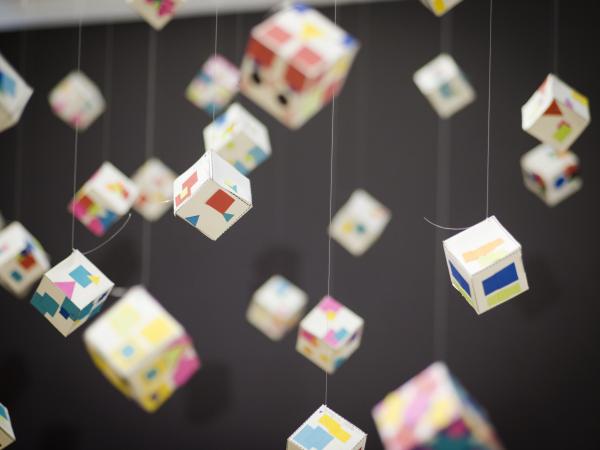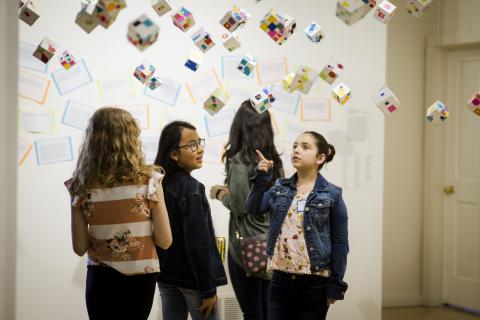Educator Resources
Express Yourself! Math Expressions

Students explore how to decompose and recompose equations and how equivalent expressions can be expressed differently.
This graphic design project uses symbols to create various expressions of the same equation on each side of a cube. Symbols represent numerical values, giving students a key from which to base their designs and equations.
Objectives:
- Students will learn to plan compositions
- Students will develop patterns using symbols
- Students will consider movement, balance, and color in their sculptures
- Students use equivalent expressions to design different patterns on each side of their sculpture
- Students will increase their understanding of equations through the development and creation of their art
Basic Lesson Outline:
- Introduce the project
- Introduce symbols and demonstrate recording, planning, and forming equivalents
- Students plan and design each side of their sculpture
- Students begin cutting and structuring their sculptures
- On the final workday for sculptures, students begin their written reflection
- Students present their sculpture as a part of a class gallery
Art Supplies:
- Construction paper
- Shape templates for 3D structures
- Templates for symbols
- Glue
- Scissors
- Envelopes
Other Resources:
- Example of designed sculpture
- Slide show to introduce project and related artwork (see outline at the end of the lesson plan)

Idaho State Learning Standards
Arts and Humanities: Anchor Standard 4: Convey meaning through the presentation/performance/production of an original work or unique interpretation of a work.
- Objective PR1.1 Combine knowledge and understanding from two or more disciplines to present/perform their original or interpreted works for an audience
- Objective PR1.2 Convey meaning through their presentation/performance
Math 6.EE. Apply and extend previous under standings of arithmetic to algebraic expressions
- Write and evaluate numerical expressions involving whole-number exponents
- Apply the properties of operations to generate equivalent expressions. For example, apply the distributive property to the expression 3 (2 + x) to produce the equivalent expression 6 + 3x; apply the distributive property to the expression 24x + 18y to produce the equivalent expression 6 (4x + 3y); apply properties of operations to y + y + y to produce the equivalent expression 3y
- Identify when two expressions are equivalent (i.e., when the two expressions name the same number regardless of which value is substituted into them). For example, the expressions y + y + y and 3y are equivalent because they name the same number regardless of which number y stands for
Academic Language:
- Subject area language: expressions, equivalent
- Art language: sculpture, movement, balance, pattern, symmetry, color, shape, form
Student Use of Vocabulary:
Students will use the words when creating, writing about, and discussing their projects
Student Grouping:
Students will work independently
Day 1 – Introduction
Introduce the project with a slide show
- Describe how art and math are related
- Provide examples of graphic design considerations (ex. balance, movement, pattern, symmetry, color, and shape)
Day 2 – Artmaking
Students will be shown a demonstration of how to record their equations prior to beginning their sculptures
- They will need to plan out the equivalent equations prior to building
Students will cut, color, and measure the shapes that they need for their project
Students will begin to organize and plan out their designs for each side of the equation
- They should try to have this finished by the end of the day
Students should sketch or take a photo of their layout for reference
At the end of class, students should put all of their work and papers in a large envelope to save their work for the next class
Day 3 – Artmaking
- After students have chosen a color scheme and cut, colored, and measured their shapes, they should build their cube and then adhere their designs
- At the end of class, students should put all of their work and papers in a large envelope to save their work for the next class
Day 4 – Artmaking
Students should finish gluing their projects together
Students will write an artist statement, which should include:
- A description of their piece, including the colors and materials they used
- An explanation of how art and math are related
- The equations they used, and how they are equal
- A description of how their piece shows movement, balance, color, and symmetry
Day 5 – Presentation
Students take turns presenting their work to the class, talking about:
- Their design and their use of symmetry, balance, color, movement, and rhythm
- Their mathematical equation
- How they discovered art and math are related
Slide examples:
We will think about:
- What is a watershed?
- Why are watersheds important?
- What is our responsibility to a watershed?
Our art is inspired by plastics and other pollutants and their effects on a watershed
- Video: What really happens to the plastic you throw away? by Emma Bryce
What is an art installation?
- A 3D, sculptural piece of art that is designed for a specific space
- The art is usually temporary and changes how people view the space
- Examples: “Paper Planes” by Dawn Ng and “Melting Man” by Nele Azevedo
Photo of recycled bottle waterfall by Chinese artist Wang Zhiyuan
Questions to ask:
- What do you see here?
- What is this made out of?
- Where do you think this is?
- What is the artist telling his audience?
- How is this art related to water?
- Why and how is this an art installation?
Photo of plastic plants by Veronika Richterova
Questions to ask:
- What do you see here?
- What materials did the artist use?
- How many bottles did she use?
Photo of plastic leaves by Veronika Richterova
Questions to ask:
- What do you see here?
- What materials did the artist use?
- How many bottles did she use?
- How did she get the leaves to take their shape?
Three ways of manipulating plastic
- Cutting
- Gluing
- Embellishment
Cutting
- Takes away material
- Creates details
- Changes surface
Examples of cut plastic
- “Green Plant” by Artist Gulnuroz Daglar
Questions to ask:
- What material is used here?
- How much of the material has been taken away?
Cut plastic art by Eduard Aldrovandi
Questions to ask:
- What material is used here?
- How many bottles do you see?
- How do you think he did this?
Gluing
- We will be using modge podge and hot glue
- What does gluing allow us to do? Enables layering and embellishment
Examples of Layering
- Artists David Edgar and Jen Stark
Questions to ask:
- What materials did the artists use?
- How many layers can you see?
- How does layering change the appearance of the materials?
More examples of layering
- Artists Aurora Robson and Michelle Reader
Questions to ask:
- What do you see here?
- How are they similar and how are they different?
Embellishment
What is embellishment?
- Decoration
- Adding to
How can we embellish our plastic creations?
Paint
Add more plastic
Add other materials
Examples of embellishment
“Wreath” by Leanne Stock
Questions to ask:
What do you see here?
How is this embellished?
Stringing together water bottles to create a waterfall:
- Poke a hole in the plastic (nail or poking tool)
- Run the string through the bottle
- Make sure the beginning and end of the string are secure
- Attach more water bottles
- Attach your string of water bottles to a classmate’s string of water bottles
Creating a plastic fish:
- Choose a water bottle as the foundation for the fish
- Cut the water bottle in different ways to change the shape
- Take the cut pieces or other pieces of plastic and hot glue them onto the fish
- Embellish fish using paint, tissue paper, modge podge, glitter glue, and colorful tape
- Run a string through the fish so we can hang it in the hall
Creating a plastic plant:
- Choose a water bottle as the foundation for the plant
- Cut the water bottle in different ways to change the shape
- Take the cut pieces or other pieces of plastic and hot glue them onto the plant
- Embellish plant using paint, tissue paper, modge podge, glitter glue, and colorful tape
- Run a string through the plant so we can hang it in the hall

0 comentarios
Leave a Comment